Dodge Journey: Differential, transaxle
DESCRIPTION
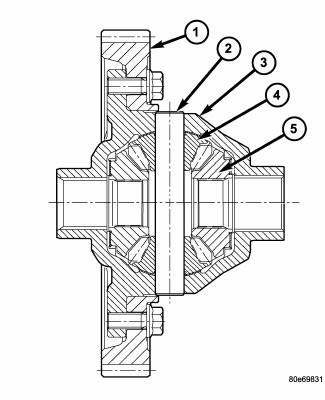
Fig. 166: Differential Assembly
- - RING GEAR
- - PINION SHAFT
- - DIFFERENTIAL CASE
- - PINION GEAR
- - SIDE GEAR
The BG6 differential is a conventional open design, and is integral to the transaxle. It consists of a single-piece case (3), which houses pinion (4) and side gears (5). A pinion shaft (2) is retained by the differential ring gear (1) and roll pin, The differential case is supported in the transaxle by tapered roller bearings.
OPERATION
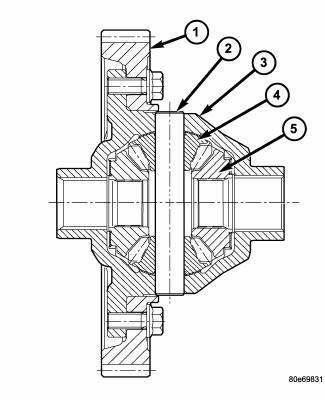
Fig. 167: Differential Assembly
- - RING GEAR
- - PINION SHAFT
- - DIFFERENTIAL CASE
- - PINION GEAR
- - SIDE GEAR
The differential assembly is driven by the intermediate shaft via the ring gear (1). The ring gear drives the differential case (3), and the case drives the halfshafts through the differential gears. The differential pinion (4) and side gears (5) are supported in the case by pinion shafts and thrust washers. Differential pinion (4) and side gears (5) make it possible for front wheels to rotate at different speeds while cornering.
REMOVAL
1. The transaxle must be removed to gain access to and service the differential assembly. 2. Disassemble transaxle and remove differential.
DISASSEMBLY
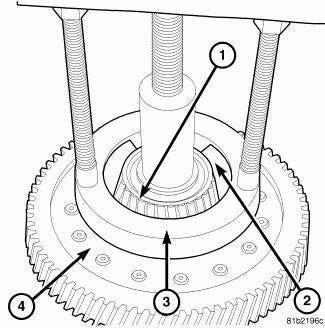
Fig. 168: Remove Differential Bearings
1. Use Plug C-293-3, Puller/Press C-293-PA (3), and Puller Adapters 9613 (2) on ring gear side (4) to remove the pinion side bearing (1).
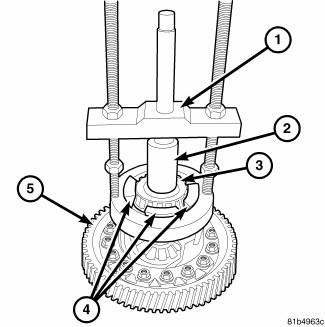
Fig. 169: Remove Differential Bearing Pinion Side
2. Use Plug C-293-3, Puller/Press C-293-PA (1) and Adapters C-293-37 (4) on pinion side with 2WD. Use Puller Adapters 9614 (4), Puller/Press C-293-PA (1) and Remover C-4656 as a plug on pinion side with a AWD to remove pinion side bearing (1).
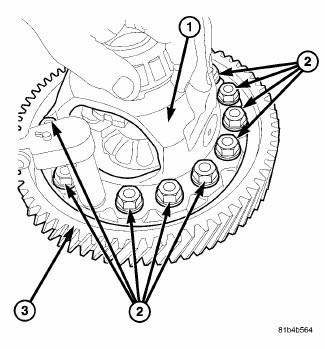
Fig. 170: Bolts At Ring Gear
3. Remove the bolts at the ring gear.
4. Remove the ring gear by taping with a soft face hammer.
ASSEMBLY
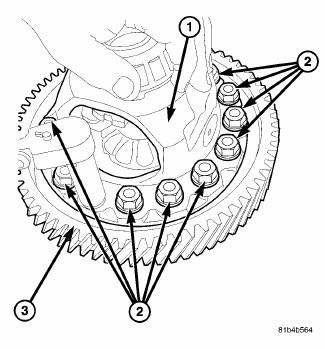
Fig. 171: Bolts At Ring Gear
1. Install differential ring gear. Install and torque ring gear-to-case bolts to 106 N.m (78 ft. lbs.).
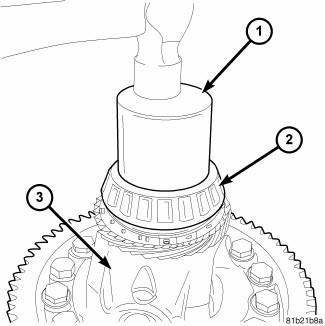
Fig. 172: Pinion Side Differential Bearing
2. Use Compressor Field Coil Remover 9354 (1) to install the pinion side differential bearing (2).
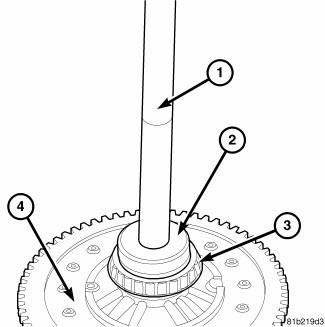
Fig. 173: Install Ring Gear Side Differential Bearing
3. Use Universal Handle C-4171 (1) and Bearing Installer 9523 (2) to install the ring gear side differential bearing (3).
INSTALLATION
1. Differential installation is part of the transaxle assembly process. Be sure to use the same differential shim that was removed upon disassembly. See Assembly.
ADJUSTMENT
BEARING ADJUSTMENT PROCEDURE
1. Use extreme care when removing and installing bearing cups and cones. Use only an arbor press for installation, as a hammer may not properly align the bearing cup or cone. Burrs or nicks on the bearing seat gives a false end-play reading while gauging for proper shims. Improperly seated bearing cups and cones are subject to low-mileage failure.
2. Bearing cups and cones should be replaced if they show signs of pitting or heat distress. If distress is seen on either the cup or bearing rollers, both cup and cone must be replaced.
3. Bearing preload and drag torque specifications must be maintained to avoid premature bearing failures.
Used (original) bearings may lose up to 50% of the original drag torque after break-in. All bearing adjustments must be made with no other component interference or gear intermesh.
4. Replace bearings as a pair: If one differential bearing is defective, replace both differential bearings, if one input shaft bearing is defective, replace both input shaft bearings.
5. Bearing cones must not be reused if removed.
6. Turning-torque readings should be obtained while smoothly rotating in either direction.
DIFFERENTIAL BEARING PRELOAD ADJUSTMENT
NOTE: True bearing turning-torque readings can be obtained only with the geartrain removed from the case.
1. Remove bearing cup and existing shim from clutch bellhousing case.
2. Press in new bearing cup into bellhousing case (or use a cup that has been ground down on the outer edge for ease of measurement).
3. Press in new bearing cup into gear case side.
4. Oil differential bearings with transmission fluid. Install differential assembly in transaxle gear case.
Install clutch bellhousing over gear case. Install and tighten case bolts to 29 N.m (257 in. lbs.).
5. Position transaxle with bellhousing facing down on workbench with C-clamps. Position dial indicator.
NOTE: The dial indicator should be parallel to T-Handle to obtain the most accurate reading.
6. Apply a medium load to differential with Torque Tool C-4995A (3) and a T-handle, in the downward direction. Roll differential assembly back and forth a number of times. This will settle the bearings. Zero the dial indicator (2). To obtain end play readings, apply a medium load in an upward direction while rolling differential assembly back and forth. Record end play.
7. The shim required for proper bearing preload is the total of end play, plus (constant) preload of 0.18 mm (0.007 in.). Never combine shims to obtain the required preload.
8. Remove case bolts. Remove clutch bellhousing differential bearing cup. Install shim(s) selected, then press the bearing cup into clutch bellhousing.
9. Install clutch bellhousing. Install and tighten case bolts to 29 N.m (257 in. lbs.).
10. Using Torque Tool C-4995A (2) and an inch-pound torque wrench (1), check turning torque of the differential assembly. The turning torque should be 9 to 22 in. lbs. If the turning torque is too high, install a 0.05 mm (0.002 inch) thinner shim. If the turning torque is too low, install a 0.05 mm (0.002 inch) thicker shim.
11. Recheck turning torque (1). Repeat until the proper turning torque is obtained.
12. Once proper turning torque has been established for the differential separate case halves, install counter shaft assembly into case with the differential and recheck differential turning torque. The turning torque should be 37 to 52 in. lbs. If the turning torque is too high, install a 0.05 mm (0.002 inch) thinner shim. If the turning torque is too low, install a 0.05 mm (0.002 inch) thicker shim.
13. Recheck total turning torque (1). Repeat until the proper turning torque is obtained.
Once proper turning torque has been established, place gear case on the end plate. Draw a bead of MOPAR Gasket Maker, Loctite 518, or equivalent, on the flat surface of the case mating flange. Install clutch bellhousing onto gear case. Install and tighten case bolts to 29 N.m (257 in. lbs.).
 Cable, gearshift control
Cable, gearshift control
REMOVAL
Fig. 161: Shift Cables & Bracket
1. Remove the shifter.
2. Raise hood.
3. Remove the resonator.
4. Remove engine cover.
5. Remove air cleaner assembly.
6. Disconnect ne ...
 Fluid
Fluid
STANDARD PROCEDURE
FLUID LEVEL CHECKING
The fluid required for this transaxle is Mopar ATF+4 (Automatic Transmission
Fluid). Use of improper or
substitute fluids can cause shift problems and/or t ...
See also:
Curb height measurement
The wheel alignment is to be checked and all alignment adjustments made with
the vehicle at its required curb
height specification.
Vehicle height is to be checked with the vehicle on a flat, le ...
Installation
2.0L TURBO DIESEL
Fig. 19: Generator Bushing
1. If reinstalling the old generator, install a generator mounting bolt and
tap bushing out slightly to ease
mounting of generator.
Fig. 20: Remo ...
Cable, gearshift control
REMOVAL
Fig. 161: Shift Cables & Bracket
1. Remove the shifter.
2. Raise hood.
3. Remove the resonator.
4. Remove engine cover.
5. Remove air cleaner assembly.
6. Disconnect ne ...
